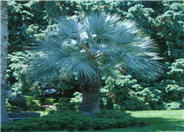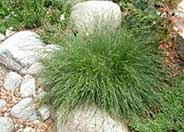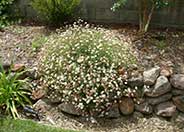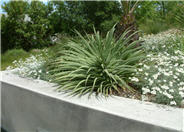
Common name:Yarrow
Botanical name:Achillea millefolium
This Achillea features spreading mats of fern-like rosettes, along with deeply divided leaves of a green or gray green color. In this form, the flowers are usually a white tone. Stems can reach 2'-3' above foliage. Yarrows propagate easily from rooted cuttings or division, which should be performed in the early spring or fall. Following bloom, one should dead head the plant and divide the clumps when it appears crowded.

Common name:Mexican Blue or Blue Hesper Palm
Botanical name:Brahea armata
This native to Mexico and Baja California displays a dense canopy of stiff fronds contrasted by graceful inflorescences that arch downward and extend well beyond the foliage.

Common name:California Field Sedge
Botanical name:Carex praegracilis
This native Carex can be successfully used as a lawn substitute but requires significant water to obtain good coverage. Once coverage is reached, water can be reduced and maintenance is close to zero. Unmowed, the plant can be used effectively in a variety of conditions and will reach a height of 6" or under and spreads up to 2' by rhizomes.

Common name:Santa Barbara Daisy, Mexican Daisy
Botanical name:Erigeron karvinskianus
This low mounding perennial, with fine leaves and white to pinkish, daisy-like flowers, is an excellent asset to rock gardens.

Common name:Candelabrum Agave, Spider Agave
Botanical name:Agave bracteosa
One of the most attractive smaller agaves, sometimes clump forming. Unarmed leaves make for a good container plant. Best in part sun to light shade. Slender recurving narrow green leaves resembles a spider. Aloe-like flowers are white-orange This agave is one of only a few, that does not die after flowering. The bloom spike is 3' of densely packed cream colored flowers. Is more moisture tolerant than others, needing good drainage. Native on limestone ledges.
Designer: Cornflower Farms
Photographer: GardenSoft
Physical weed control, including mulching, or hand removal protects the watershed from harmful chemicals.
Check the soil's moisture level before watering.
You can reduce your water use 20-50% by regularly checking the soil before watering.
Drip and other smart irrigation delivers water directly to roots, allowing no excess water for weeds.